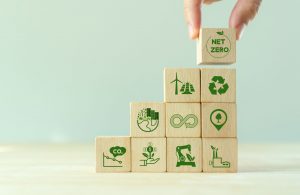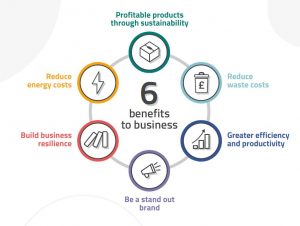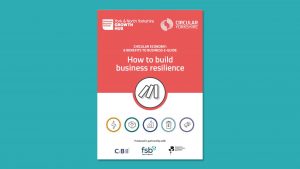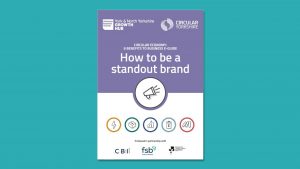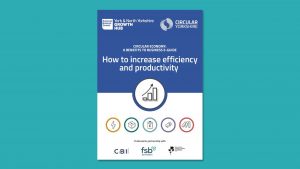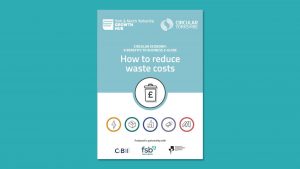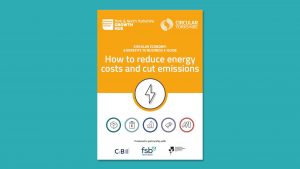
Developing a sustainability plan
Developing a sustainability plan is a key step in committing your business to responsible and ethical practices. Here, we take you through the building blocks of creating a comprehensive sustainability plan for your business – big or small – to help minimise its environmental footprint, promote social responsibility, and foster long-term resilience and growth.

Audit your current situation
The first step in developing a sustainability plan is to understand your current environmental and social impact. Conduct a thorough audit of your operations to identify areas where sustainability efforts can be most effective. Consider factors such as energy consumption, waste generation, carbon emissions, supply chain ethics, and community engagement. Read our guide to conducting a sustainability audit.
Set your objectives
Once you have a better understanding of your business’ current sustainability performance, set clear and measurable objectives. Your goals should be specific, achievable, and time-bound. For instance, you might aim to reduce energy consumption by 20% within the next two years, or to achieve zero-waste status by 2030.
Involve key stakeholders – and ask for advice
Sustainability is a collective effort, so involve key stakeholders within your business. Engage employees, management, and even customers in the sustainability planning process. This inclusivity fosters a sense of shared responsibility and ensures that your sustainability plan has broad buy-in.
You may also seek advice from an environmental or sustainability consultant, someone with experience of helping other organisations make real change in their practice.
Develop a comprehensive action plan
Outline the specific steps and strategies that will help you achieve your sustainability objectives. Address each aspect of your business operations, from energy efficiency and waste reduction to responsible sourcing and product innovation. Be sure to consider how these actions align with local and international sustainability standards, such as the Sustainable Development Goals (SDGs).
Budget, capacity, resources
Sustainability initiatives often require an initial investment of time, money, and resources. Allocate the necessary resources to implement your sustainability plan effectively. This may involve budgeting for energy-efficient equipment, and ensuring that any employees tasked with implementing changes have time to do this alongside their existing roles, and time for appropriate training. It may be difficult to do it all at once, so consider a phased approach, so you maintain progress and keep momentum.
Monitor progress
Establish a system for monitoring and measuring your progress toward your sustainability goals. Regularly track key performance indicators (KPIs) such as energy usage, waste reduction, and carbon emissions. Use data-driven insights to assess your progress, identify areas for improvement, and adapt your sustainability plan as needed.
Sustainability is an ongoing journey. Regularly review your sustainability plan and make adjustments as needed to keep going, and achieve the change in your business you want to see.

Learn more
From Grants to Growth: Securing Funding for Rural Business
Rural subsidies are complex – so we asked our rural business specialist Nick White to give us his top tips for getting the funding your business needs to succeed.
Growth Hub Welcomes New Business Advisors for North Yorkshire
We are delighted to announce the addition of three new team members who will play a crucial role in supporting local businesses and entrepreneurs as business advisors for North Yorkshire.
Business sustainability support available
This scheme of business sustainability support includes several options for small and medium businesses including grants and fully funded audits.
Harnessing Heat Recovery: Crimple's Path to Cost Savings and Sustainability
Crimple, a busy Bistro and Foodhall, aimed to reduce its environmental impact and lower its power consumption through heat recovery.
Ellis Patents' £400K Solar Power Investment Boosts Business
With a solar power investment totalling over £400,000, Ellis Patents has successfully installed 173 new solar panels at its headquarters.
Knowing what to say: the Green Claims Code and ‘sustainable’ business
Claiming your business, product or service is sustainable is a big win, but it's important to make sure you're saying the right thing. The Green Claims Code can help you talk about your net zero credentials with six key elements.
Talking Net Zero: Why does the accuracy of words matter to your business?
Do you understand the key climate change terms every business should know? Get to grips with net zero terminology and learn how you can use it to your advantage with our free resources.
Why Business Continuity is Important
Preparing for the challenges a business might come up against when times get tough can seem like a mammoth task. You want to protect your business and guarantee that it can survive the adversity. It can be helpful to think about why you’re making a plan to ensure business continuity. Once you have in mind
Innovative cost saving ideas for businesses
Innovation does not have necessarily have to involve a...
6 ways to make your business more sustainable
How can you, as a small business, have a more positive impact on the environment?
Reducing waste within your supply chain
If you are looking at how you can reduce...
Events
05th June 202412:00 pm - 2:00 pmFREE
York Retrofit Network
Come and join the York Retrofit Network, which is part of a wider project supported by Innovate UK to create a Retrofit One-Stop-Shop for York.
05th June 202412:00 pm - 2:00 pmFREE
Glossary of Climate Change Terms for Businesses
A free digital glossary defining the key climate change terms relevant to businesses, to help you understand and engage with sustainability resources and support.
05th June 202412:00 pm - 2:00 pmFREE
Net-Zero Business Toolkit
The Net-Zero Business Toolkit aims to make sustainability simple and is suitable for businesses of any sector or size. Download the toolkit today to get started or continue with your net-zero journey.
05th June 202412:00 pm - 2:00 pmFREE
6 benefits to business - download all guides
Download all of our free guides on how to be more sustainable in your business and start benefiting from the circular economy.
05th June 202412:00 pm - 2:00 pmFREE
How to build business resilience
The global COVID-19 pandemic and other threats such as the EU exit, are forcing us to think about business resilience.
05th June 202412:00 pm - 2:00 pmFREE
How to create products with purpose
Consumer demand for quality products that last is at an all time high and purpose is becoming an important part of many businesses.
05th June 202412:00 pm - 2:00 pmFREE
How to be a standout brand
Consumers are increasingly looking for brands which have sustainability at their core.
05th June 202412:00 pm - 2:00 pmFREE
How to increase efficiency and productivity
Limiting the natural resources we use and making the most of existing ones is a cornerstone of the circular economy.
05th June 202412:00 pm - 2:00 pmFREE
How to reduce waste costs
The cost of disposing of waste is increasing and regulations around disposal are tightening. Read our guide on how to reduce these.
05th June 202412:00 pm - 2:00 pmFREE
How to reduce energy costs and cut emissions
One of the quickest and easiest ways to take a step towards a circular economy model is to reduce the energy you use.














